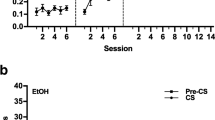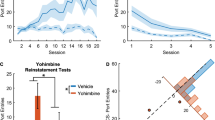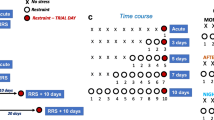Abstract
Two experiments examined the long-term effects of repeated administration of yohimbine, a suspected anxiogenic drug, on behavioral sensitivity to a conditioned cue for shock. In Experiment 1, rats were trained to bar press following injection of yohimbine (either 1 or 2 mg/kg) or saline. At the end of this training, injections were suspended and the rats were given Pavlovian fear conditioning to establish a light as a shock signal. Rats were then returned to the bar press situation (about 2 weeks after their last injection) and the capacity of the light to disrupt responding was tested. Rats previously treated with yohimbine were less disrupted by the light than were controls. In contrast, Experiment 2 found that previously experiencing the yohimbine-induced state only in the home cage increased subsequent disruption of bar pressing by the light. Yohimbine pretreatment had no effect on acquisition of freezing behavior to the light, nor on bar pressing during testing in the absence of the light, in either experiment. The results show that yohimbine can have long-term effects on behavior in the presence of a stressor, and that the nature of these effects are dependent upon environmental and/or behavioral context in which the yohimbine-induced state was experienced. These findings appear compatible with an internal stimulus view of stress and stress inoculation.
Similar content being viewed by others
References
Bolles RC, Collier AC (1976) The effects of predictive cues on freezing in rats. Anim Learn Behav 4:6–8
Browne RG (1981) Anxiolytics antagonize yohimbine's discriminative stimulus properties. Psychopharmacology 74:245–249
Charney DS, Heninger GR, Redmond Jr DE (1983) Yohimbine induced anxiety and increased noradrenergic function in humans: Effects of diazepam and clonidine. Life Sci 33:19–29
Crow TJ (1968) Cortical synapses and reinforcement. Nature 219:736–737
Davis M, Redmond Jr DE, Barabon JM (1979) Noradrenergic agonists and antagonists effects on conditioned fear as measured by the potentiated startle paradigm. Psychopharmacology 65:111–118
Delini-Stula A, Baumann P, Buch O (1979) Depression of exploratory activity by clonidine in rats as a model for the detection of relative pre- and postsynaptic central noradrenergic receptor selectivity of alpha-adrenolytic drugs. Naunyn-Schmiedeberg's Arch Pharmacol 307:115–122
Eysenck HJ (1983) Stress, disease, and personality: The ‘inoculation effect’. In: Cooper CL (ed) Stress research. Wiley, Chichester, pp 121–146
Fanselow MS, Bolles RC (1979) Naloxone and shock-elicited freezing in the rat. J Comp Physiol Psychol 93:236–244
Gray JA, Davis N, Owen S, Feldon J, Boarder M (1981) Stress tolerance: possible neural mechanisms. In: Christie MJ, Millett PG (eds) Psychosomatics. Wiley, New York
Guttmacher LB, Murphy DL, Insel TR (1983) Pharmacologic models of anxiety. Comp Psychiatry 24:312–326
Hamberger LK, Lohr JM (1984) Stress and stress management. Springer, New York
Hoffman LA, Weiss JM (1986) Behavioral depression following clonidine withdrawal: A new animal model of long-lasting depression? Psychopharmacol Bull (in press)
Holmberg G, Gershon S (1961) Autonomic and psychic effects of yohimbine hydrochloride. Psychopharmacologia 2:93–106
Kimmel HD (1975) Conditioned fear and anxiety. In: Sarason IG, Spielberger CD (eds) Stress and anxiety, vol 1. Wiley, New York
Lal H, Emmett-Oglesby MW (1983) Behavioral analogues of anxiety: animal models. Neuropharmacology 22:423–1441
Meichenbaum D (1977) Cognitive behavior modification: Plenum, New York
Miller NE (1980) Effects of learning on physical symptoms produced by psychological stress. In: Selye H (ed) Selye's guide to stress research, vol 1. Van Nostrand Reinhold, New York pp 131–167
Pellow S, Chopin P, File SE (1985) Are the anxiogenic effects of yohimbine mediated by its action at benzodiazepine receptors? Neurosci Lett 55:5–9
Redmond Jr DE, Huang YH (1979) Current concepts II. New evidence for a locus coeruleus-norepinephrine connection with anxiety. Life Sci 25:2149–2162
Reisine T, Johnson R, Wiech N, Ursillo R, Yamamura HI (1982) Rapid desensitization of central beta-receptors and up-regulation of alpha2-receptors following antidepressant treatment. In: Costa E, Racagni G (eds) Typical and atypical antidepressants. Raven, New York, pp 63–67
Rescorla RA, Solomon RL (1967) Two-process learning theory: Relationship between Pavlovian conditioning and instrumental learning. Psychol Rev 74:151–182
Sara SJ (1985) The locus coeruleus and cognitive function: Attempts to relate noradrenergic enhancement of signal/noise in the brain to behavior. Physiol Psychol 13:151–162
Schachter S, Singer JE (1962) Cognitive, social, and physiological determinants of emotional state. Psychol Rev 69:379–399
Segal M (1985) Mechanisms of action of noradrenaline in the brain. Physiol Psychol 13:172–178
Starke K (1977) Regulation of noradrenaline release by presynaptic receptor systems. Rev Physiol Biochem Pharmacol 77:1–124
Starke K, Borowski E, Endo T (1975) Preferential blockade of presynaptic alpha2-adrenoreceptors by yohimbine. Eur J Pharmacol 13:454–473
Velley L, Cardo B (1979) Long-term improvement of learning after early electrical stimulation of some cenetral nervous system structures: Is the effect structure and age-dependent? Brain Res Bull 4:459–466
Velley J, Kempf E, Cardo B, Velley L (1985) Long-term modulation of learning following locus coeruleus stimulation: Behavioral and neurochemical data. Physiol Psychol 13:163–171
Author information
Authors and Affiliations
Rights and permissions
About this article
Cite this article
Davidson, T.L., Lucki, I. Long-term effects of yohimbine on behavioral sensitivity to a stressor. Psychopharmacology 92, 35–41 (1987). https://doi.org/10.1007/BF00215476
Received:
Revised:
Issue Date:
DOI: https://doi.org/10.1007/BF00215476




